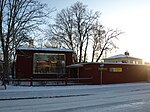Håga mound
Buildings and structures in UppsalaGermanic archaeological sitesHistory of UppsalaNordic Bronze AgeTumuli in Sweden ... and 1 more
Uppsala

The Håga mound (Hågahögen) or King Björn's Mound (Kung Björns hög) is a large Nordic Bronze Age tumulus in the western outskirts of Uppsala, Sweden. It is one of the most magnificent remains from the Nordic Bronze Age. It is Scandinavia's most gold-rich bronze age grave ever found.
Excerpt from the Wikipedia article Håga mound (License: CC BY-SA 3.0, Authors, Images).Håga mound
Hågavägen, Uppsala Håga
Geographical coordinates (GPS) Address Nearby Places Show on map
Geographical coordinates (GPS)
| Latitude | Longitude |
|---|---|
| N 59.833333333333 ° | E 17.583333333333 ° |
Address
Hågavägen
752 63 Uppsala, Håga
Sweden
Open on Google Maps







